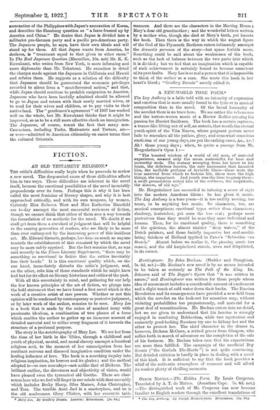FICTION.
AN OLD TESTAMENT RELIGION.*
THE critic's difficulties really begin when he proceeds to review a new novel. The deep-seated cause of these difficulties affects him in two ways. These difficulties are inherent in the novel itself, because the emotional possibilities of the novel invariably preponderate over its form. Perhaps this is why it has been called the most feminine of literary shapes, and why it is best approached critically, and with its own weapons, by women. Certainly Miss Rebecca West and Miss Katherine Mansfield are to-day amongst the most successful reviewers of fiction, though we cannot think that either of them sees a way towards the formulation of an aesthetic for the noveL We doubt if we shall get from them a standard of judgment that will be helpful to the coming generation of readers, who are likely to be more than ever endangered by the increasing power of this insidious art. Mr. Edward Garnett, perhaps, has done as much as anyone towards the establishment of that standard by which the novel may be more safely apprised. But the fact remains that, as was said recently in the Times Literary Supplement, " there may be something so emotional in fiction that the critics inevitably lose their heads." It is this emotional quality which, on the one hand, immediately disturbs the critic's judgment, and, on the other, robs him of those standards which he might have had but for its effect on literary historians and critics of the past.
With all this uncertainty in mind, and gathering for our help the few known principles of the art of fiction, we plunge into the bold statement that we have found a first novel which is the work of a creative artist of rare powers. Whether or not this opinion will be confirmed by contemporary or posterior judgment, or by later work of the author, remains to be seen. Mary Lee is a book that is made by the union of mordant irony with passionate idealism, a combination of two phases of a force which enables the author to gather up an immense amount of detailed material and to utilize every fragment of it towards the structure of a profound purpose.
The story is the autobiography of Mary Lee. We see her from the time of her birth in the 'fifties, through a childhood and youth of physical, mental, and moral slavery amongst a fanatical religious sect, to the moment of her emancipation from her resultant nervous and diseased imaginative condition under the healing influence of love. The book is a searching inquiry into religious inspiration, its horrors and its glories ; and the method adopted is—so rare nowadays—not unlike that of Dickens. The brilliant outline, the directness and objectivity of vision, would have pleased even the tyrannical old Goethe. There are char- acters here who we feel will linger in our minds with that assembly which includes Becky Sharp, .Silas Marner, John Christopher, and Tess. The terrible Aunt Jael is a masterpiece, and so is the old madwoman Glory Clinker, with her eccentric table • Nary Lee, 13y Geoffrey Dennis, London; Heinemann. 17x. #3(L.1
manners. And there are the characters in the Meeting House ; Mary's dear old grandmother ; and the wonderful letters written by a mother who, though she died at Mary's birth, yet haunts the book. Then there is the way in which the august figure of the God of the Plymouth Brethren enters intimately amongst the dramatis personae of the story—but space forbids more. Something could be said about the weaknesses of the book, such as the lack of balance between the two parts into which it is divided ; but we feel that an imagination which is capable of such achievement is certainly bound to become conscious of its past faults. Mary Lee is so real a person that it is impossible to think of the author as a man. She wrote this book in her heart's blood ; "Geoffrey Dennis" merely edited it.


































 Previous page
Previous page